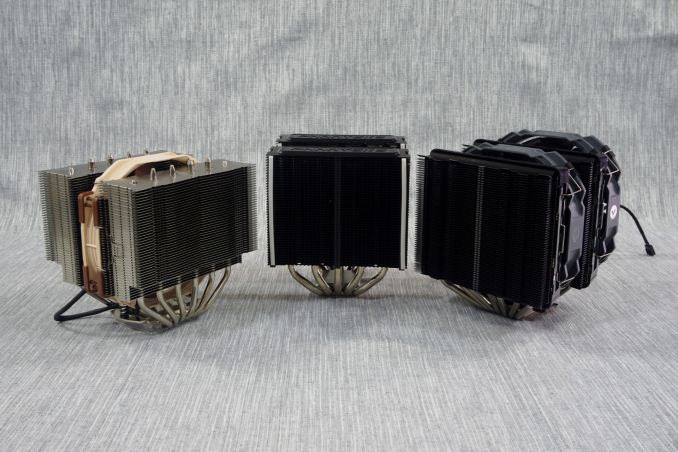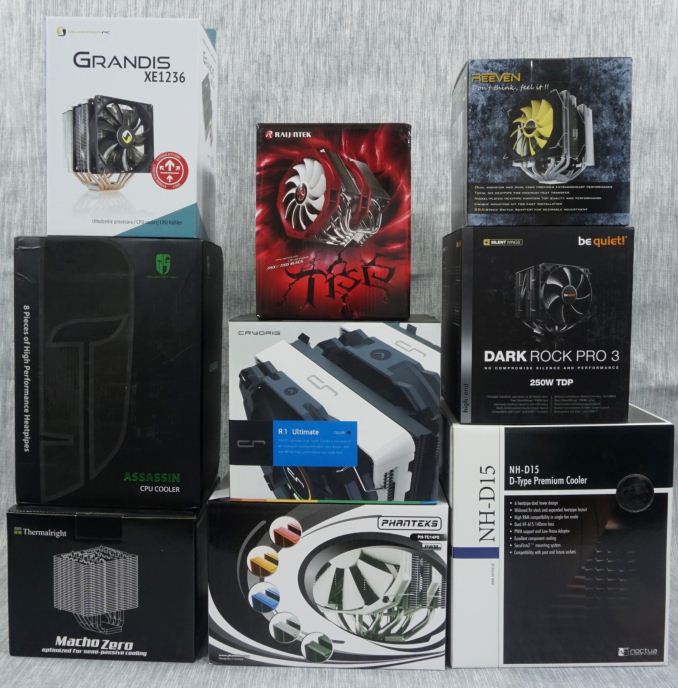Top Tier CPU Air Coolers Q3 2015: 9-Way Roundup Review
by E. Fylladitakis on July 6, 2015 8:00 AM EST
Brace yourselves, summer is coming. As it happens every summer, the sales of advanced cooling solutions tend to increase this time of the year. This year a little more than usual, as many enthusiasts likely found the perfect excuse for an upgrade in light of the new Windows 10 release. Rising temperatures are a concern for both the casual user, who usually is just psychologically stressed by the higher temperature readings, and the advanced enthusiast, whose overclocked system is now facing random stability issues. And of course there are those who are simply annoyed by the increasing noise of their current cooling solution and are in need of something less intrusive.
Liquid-based cooling solutions are becoming easier to install and AIO kits generally are hassle-free, yet they are still not favored by the majority of the users. Their space requirements, increased complexity and price hold most people to simple air-based cooling solutions. After all, most advanced users are not quite convinced about the performance of AIO coolers to begin with, with some even claiming that air-based solutions can be as good or even better.
We have not had a review of simple air-based cooling solutions in a while here in AnandTech. With a new advanced testing setup and equipment, it makes sense to begin with roundup reviews, which present multiple current solutions and create a healthy reference database. However, there are thousands of air-based cooling products available and almost every one of them is designed for a specific purpose and target group. We had to start from a single category, therefore we simply requested from a number of companies to ship us whichever product they consider their best. Nine companies answered our call, alphabetically listed in the table below.
| Product | Fans | Fan Speed (RPM) |
Current Retail Pricing |
| be quiet! Dark Rock Pro 3 | 1 × 135mm 1 × 120mm |
1400 1700 |
$86.50 |
| Cryorig R1 Ultimate | 2 × 140mm | 700-1300 | $196** |
| Logisys (DeepCool) GamerStorm Assassin |
1 × 140mm 1 × 120mm |
700-1400 1200 |
$56.90 |
| Noctua NH-D15 | 2 × 140mm | 300-1500 | $93 |
| Phanteks PH-TC14PE | 2 × 140mm | 700-1200 | $80 |
| Raijintek Tisis | 2 × 140mm | 600-1000 | 64€ (≈$72*) |
| Reeven Okeanos RC-1402 | 1 × 140mm 1 × 120mm |
300-1700 300-1800 |
60€ (≈$66*) |
| SilentiumPC Grandis XE1236 | 2 × 120mm | 500-1500 | £34.90 (≈$45*) |
| Thermalright Macho Zero | - | - | $65 (no fan) |
*As these coolers are not available in the US at the time of the review, these are the average retail prices in USD, excluding taxes.
**The Cryorig R1 Ultimate currently is available only through a foreign store registered in Amazon.com that ships from Korea. The current retail price is extremely bloated, far above the MSRP.











135 Comments
View All Comments
zodiacfml - Tuesday, July 7, 2015 - link
Someone should test for this. It is quite plausible as it will take time to increase the temperature of water/coolant in the system. Yet, for longer and continuous loads, surface area matters to dump heat in the environment which AIO coolers has less to a similarly priced Big Air cooler which shows in benchmarks.Navvie - Tuesday, July 7, 2015 - link
Pretty good.It'd be nice if there was a base line (say intel's current stock cooler) and an AIO water cooler to show the difference between a top tier air cooler and what many consider to be the next step.
One point, SPCR always test each cooler with a 'reference' fan, making it easier to compare the heatsink's efficiency. Can't help but feel you didn't complete the task you set out to by levelling the playing field with your simulated CPU heat source.
maximumGPU - Tuesday, July 7, 2015 - link
Great roundup! i for one still believe high end air a good alternative to water if you want dead silence.What i still can't understand is how can Nocuta get away with shipping the most expensive air cooler, likely to be used by enthusiasts who care about aesthetics, with the most hideous fan colours?
'nar - Tuesday, July 7, 2015 - link
Noctua colors are odd, but I think it forces you to consider performance more than aesthetics. They do look nice, but not "cool" - no pun in tended.Dead silence basically depends on how much heat you need to dissipate, temperature of ambient air, surface area of fins/radiator, air flow, and heat transfer capability of the cooler. Or more basically, how easily you can transfer heat from CPU to the air. Water increases the efficiency of heat transfer, so once you reach a certain power level they will overtake HSF's. They will never be as quite as a good HSF, at least not on low-power CPU's that arguably do not need anything but the stock cooler to begin with.
xthetenth - Tuesday, July 7, 2015 - link
Noctua gets away with those colors entirely because they're Noctua. Yes they're not pretty colors, but unlike nice bright/garish colors they are an unmistakable sign that they're the best or at least tied for best.piroroadkill - Wednesday, July 8, 2015 - link
Your keyboard seems to have a problem, you've typed "hideous" when clearly "fantastic" would be better. Noctua fans are neat.Beaver M. - Wednesday, July 15, 2015 - link
Well, serious people are more likely to buy Noctua anyway. And no serious user cares about what the fans look like, and even if they did, they would still take the Noctua, since you can CLEARLY see the extremely high quality they are just by looking at them. Windows in cases and other stupid bling bling is for the PC-ricer gang. They only choose after looks anyway, and dont care if their fans make noises from day one.PrinceGaz - Tuesday, July 7, 2015 - link
Excellent review of what seem to be very good HSFs throughout (but then again, you did ask them to send their best).A comparison with the stock Intel cooler as supplied with something like the 4790K would be nice, as that is what any expense on a third-party cooler must be compared against. How would the stock-cooler compare at 340W? I was very impressed with the degC/W figures for all those coolers; it almost makes 340W seem an amount of heat that can be dealt with, though I'm thinking it's crazy.
As well as the stock-cooler from a highish end CPU, one or two commonly used AIO liquid-coolers needs to be added to provided a second comparison point, as these high-end air-coolers are presumably expected to be near, possibly even better than a liquid AIO.
I love the fact you are using a properly designed heating rig, and your comprehensive review, but I came away thinking: they're good! But I've no idea how much better they are than the stock cooler, or how any of them would compare with the liquid AIOs also available, both in terms of cooling or noise.
Sivar - Tuesday, July 7, 2015 - link
This is probably the best CPU cooler article I've read (and I read such articles when Anandtech when it was on Geocities).Excellent writing, useful measurements, and a cogent conclusion. Thank you, Emmanouil!
orangesky - Tuesday, July 7, 2015 - link
SilentPcReview just posted a review of the new Scythe Ninja 4: http://www.silentpcreview.com/article1462-page1.ht... The review includes some good comparison tables with many of the popular air & water coolers.Sounds like a pretty decent option, and probably the best Ninja since the original.